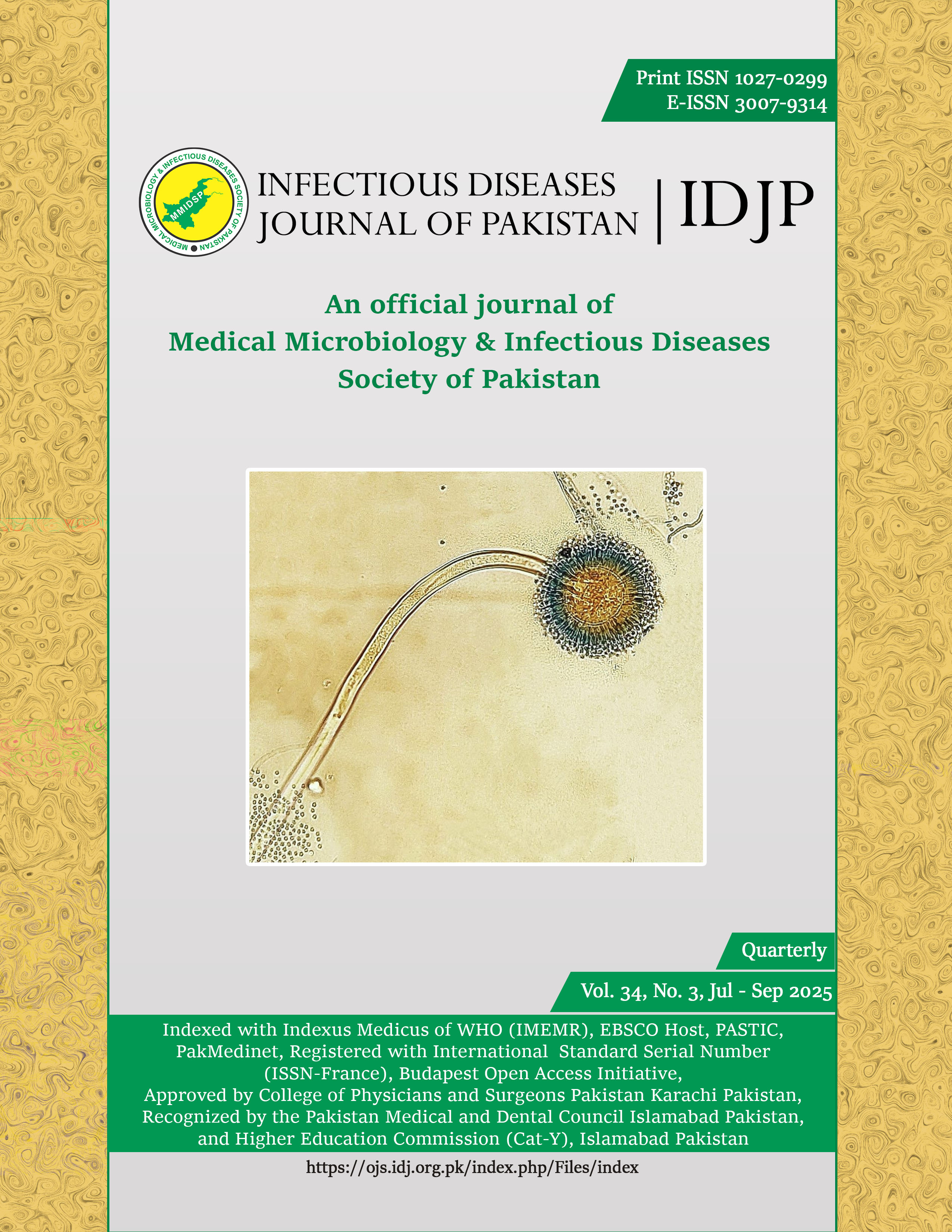Cross-sectional study of tuberculosis infection among household contacts of patients with pulmonary tuberculosis
DOI:
https://doi.org/10.61529/idjp.v34i3.435Abstract
Background: Tuberculosis (TB) remains a major public health concern, particularly among household contacts of pulmonary TB patients, where transmission risk is high. This study assessed the prevalence of positive TB screening tests and identified key demographic, behavioral, and environmental risk factors associated with infection.
Materials and Methods: The cross-sectional analytical study was done at the Department of Medicine, Mardan Medical Complex, Mardan, from October 2023 to March 2024 including 286 household contacts of confirmed pulmonary TB cases. Participants underwent Tuberculin Skin Test (TST), Interferon Gamma Release Assay (IGRA), chest X-ray, sputum smear microscopy, and GeneXpert MTB/RIF testing. Logistic regression was performed to identify independent predictors of TB infection, adjusting for potential confounders.
Results: Positivity rates were 31.5% for TST, 29.7% for IGRA, 17.5% for chest X-ray suggestive of TB, 10.5% for sputum smear microscopy, and 9.8% for GeneXpert. Independent predictors included older age (≥35 years), absence of BCG vaccination, HIV positivity, current smoking, close sleeping proximity to the index patient, and poor household ventilation (all p < 0.05). Diabetes showed borderline significance, while sex and former smoking were not significant.
Conclusion: TB infection among household contacts is influenced by a combination of biological, behavioral, and environmental factors. Targeted interventions, including vaccination, smoking cessation, HIV care, and improvements in household ventilation, could substantially reduce transmission risk.
Keywords: Tuberculosis, Household contacts, BCG vaccination, HIV, Smoking, Ventilation.
References
Zhang T, Zhang J, Wei L, Liang H, Zhang J, Shi D, et al. The global, regional, and national burden of tuberculosis in 204 countries and territories, 1990–2019. J Infect Public Health. 2023;16(3):368-75. DOI https://doi.org/10.1016/j.jiph.2023.01.014
Al Khatib A, Hassanein S, Almari M, Koubar M, Fakhreddine S. Tuberculosis morbidity and mortality during the COVID-19 pandemic: A life-threatening complex challenge. Front Cell Infect Microbiol. 2024; 14: 1423081.
DOI: https://doi.org/10.3389/fcimb.2024.1423081
Chakaya J, Khan M, Ntoumi F, Aklillu E, Fatima R, Mwaba P, et al. Global Tuberculosis Report 2020–Reflections on the Global TB burden, treatment and prevention efforts. J Infect Dis. 2021; 113: S7-12. DOI: https://doi.org/10.1016/j.ijid.2021.02.107
Bhargava A, Bhargava M, Juneja A. Social determinants of tuberculosis: context, framework, and the way forward to ending TB in India. ExpRev Respirat Med. 2021; 15(7): 867-83. DOI: https://doi.org/10.1080/17476348.2021.1832469
Mejbel FA, Aljanaby IA, Aljanaby AA. Pulmonary tuberculosis risks and challenges. InE3S Web of Conferences 2023; 381: 01101. DOI: https://doi.org/10.1051/e3sconf/202338101101
Turner RD, Bothamley GH. Cough and the transmission of tuberculosis. J Infect Di. 2015; 211(9): 1367-72. DOI: https://doi.org/10.1093/infdis/jiu625
Naidoo K, Naicker N. Epidemiology of drug-susceptible, drug-resistant tuberculosis and HIV in Africa. InHIV and Tuberculosis: A Formidable Alliance 2019 (pp. 9-23). Cham: Springer International Publishing. DOI: https://doi.org/10.1007/978-3-030-29108-2_2
Begun M, Newall AT, Marks GB, Wood JG. Contact tracing of tuberculosis: A systematic review of transmission modelling studies. PlosOne. 2013; 8(9): e72470. DOI: https://doi.org/10.1371/journal.pone.0072470
Munn Z, Moola S, Lisy K, Riitano D, Tufanaru C. Methodological guidance for systematic reviews of observational epidemiological studies reporting prevalence and cumulative incidence data. Int J Evid Based Healthc. 2015; 13(3): 147-53. DOI: https://doi.org/10.1097/XEB.0000000000000054
Nadeem M. Factors influencing access to tuberculosis diagnostic services in Pakistan–an analysis. 2023. Available from: https://bibalex.org/baifa/Attachment/ Documents/i9FTUpxE1O_20231123114730482.pdf
Burke RM, Nliwasa M, Feasey HR, Chaisson LH, Golub JE, Naufal F, et al. Community-based active case-finding interventions for tuberculosis: a systematic review. Lancet Public Health. 2021; 6(5): e283-99. DOI: https://doi.org/10.1016/S2468-2667(21)00033 -5
WHO Guidelines Approved by the Guidelines Review Committee. Latent tuberculosis infection: updated and consolidated guidelines for programmatic management. Geneva: World Health Organization. 2018. DOI: https://www.who.int/publications/i/item/W HO-CDS-TB-2018.4
Fox GJ, Barry SE, Britton WJ, Marks GB. Contact investigation for tuberculosis: A systematic review and meta-analysis. Eur Respir J. 2012; 41(1): 140-56. DOI: https://doi.org/10.1183/09031936.00070812
Krishnamoorthy Y, Ezhumalai K, Murali S, Rajaa S, Jose M, Sathishkumar A, et al. Prevalence and risk factors associated with latent tuberculosis infection among household contacts of smear-positive pulmonary tuberculosis patients in South India. Trop Med Int Health. 2021;26(12):1645-51. DOI: https://doi.org/10.1111/tmi.13693
Lu Y, Cai G, Liu Y, He F, Aoyagi K. Epidemiological features of tuberculosis infection in a rural prefecture of Japan from 2007 to 2018. SciRep. 2022; 12(1): 13511. DOI: https://doi.org/10.1038/s41598-022-17608-y
Yang J, Lee S, Oh S, Han S, Park SY, Kim Y, et al. The risk of active tuberculosis among individuals living in tuberculosis-affected households in the Republic of Korea, 2015. PlosOne. 2019; 14(12): e0225744.
DOI: https://doi.org/10.1371/journal.pone.0225744
Roy A, Eisenhut M, Harris RJ, Rodrigues LC, Sridhar S, Habermann S, et al. Effect of BCG vaccination against Mycobacterium tuberculosis infection in children: Systematic review and meta-analysis. BMJ. 2014; 349. DOI: https://doi.org/10.1136/bmj.g4643
Mangtani P, Abubakar I, Ariti C, Beynon R, Pimpin L, Fine PE, et al. Protection by BCG vaccine against tuberculosis: A systematic review of randomized controlled trials. Clin Infect Dis. 2014; 58(4): 470-80. DOI: https://doi.org/10.1093/cid/cit790
Velen K, Shingde RV, Ho J, Fox GJ. The effectiveness of contact investigation among contacts of tuberculosis patients: A systematic review and meta-analysis. Eur Respir J. 2021; 58(6): 2100266. DOI: https://doi.org/10.1183/13993003.00266-2021
Praveen V. Prevalence of LTBI among household contacts of sputum-positive TB patients receiving DOTS chemotherapy. Indian J Tuberc. 2020; 67(4): 459-65. DOI: https://doi.org/10.1016/j.ijtb.2020.07.007
Downloads
Published
How to Cite
Issue
Section
License
Copyright (c) 2025 Editor Office

This work is licensed under a Creative Commons Attribution-NonCommercial 4.0 International License.



